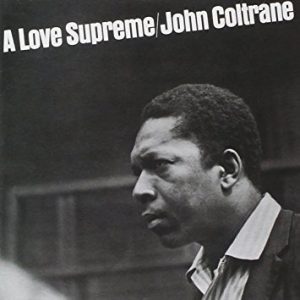
BY NECDET BALKIR GÖKA (ME/IV) balkir.goka@ug.bilkent.edu.tr
This is a trip to our emotions. At first, you might think that you are lost in the dark, but the images will become clearer as you proceed. Just do not ignore what you see, and focus on it. You will discover and acknowledge what you truly are.
That is what the first track of John Coltrane’s masterpiece album “A Love Supreme” is about. Titled “Acknowledgement,” the piece starts with a “gong,” and Coltrane prepares for the journey. The bass line, played by Jimmy Garrison, comes in, symbolizing the beginning of the journey. At first, it is like darkness inside yourself. Then, everything starts to become clearer and more defined; your eyes get used to the darkness and you are able to see your surroundings. The piano and drums develop the structure of the environment, and Coltrane tries to explore this new world. The experience is like space travel: when you exit the atmosphere, it feels like you are floating in infinity. After that, you start to explore the images you see. The track ends with another bass line, and the first phase of the journey is over.
The second track, “Resolution,” is very different from the first, much stronger and more compact. As we can see from the title, the acknowledgement stage of this inner journey is over, and every image and the corresponding feelings are precise, indicating that Coltrane is finding out who he is, which gives him strength. The instruments are in a perfect relationship, and Coltrane does not try to find the correct form the way he does in the first track; he plays with the other musicians. There is a line that he repeats over and over, which symbolizes becoming one with the surroundings.
The third track, “Pursuance,” starts with an energetic drum solo played by Elvin Jones. It is hard to follow this solo because it is very busy, changes so much and grows continuously. In my view, this track exhibits curiosity and excitement. The piano solo, played by McCoy Tyner, is very up-tempo, and the drums maintain the energy throughout the piece. One of the highlights of the track is Garrison’s double bass part, which is like running without breathing. Up to the point where Coltrane’s saxophone enters, the instruments diverge unexpectedly. If you listen this track with the saxophone solo muted, you realize that there is no space for the saxophone, because all the elements are free and there is no fundamental support for a solo to be developed on. However, Coltrane does not ask permission to enter. The song finishes with Garrison playing a solo in a somewhat relaxed fashion; it is like taking a deep breath and trying to be calm.

The last track is “Psalm”: the final stage of self-discovery. It starts with an emotional, dark saxophone melody. Other instruments then develop the feeling that saxophone expresses. The sounds are large at the beginning, giving you a sense of space and depth; you feel like you are flying in the sunrise alone. “Psalm,” meaning anthem or hymn, has a religious connotation. According to Coltrane, a divine force can be found in everything. He exists because of this divine force, and so he gives thanks in an emotional way for what he possesses.
The album was recorded by Coltrane’s classic quartet: Elvin Jones on drums, Jimmy Garrison on bass and McCoy Tyner on piano, in addition to Coltrane himself on saxophone. All of them are extraordinary musicians. Although I have interpreted the meanings of the tracks from my point of view while also focusing on what motivated Coltrane as he wrote this thought-provoking, technically pleasing album, all of the musicians had a significant impact on the music. Jazz is collective; every musician improvises his/her unique solo around a main melody. Therefore, it is important not to listen to this album as Coltrane’s alone.
